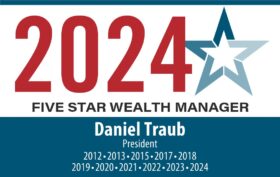Those of you keeping track at home may recall that while over 75 percent of economists were predicting a recession in 2022 and 2023, I was not.
What did I get right that they didn’t?
First, I surmised that many of the factors leading to higher inflation were transient. Second, I never saw a collapse in consumer spending.
Instead of a country-wide recession over the last two years, what likely happened was a series of rolling segmented recessions.
Consider the list of companies with significant lay-offs in 2022 and 2023.
Many industries struggled (travel/leisure, automotive, financial, technology), but not at the same time and not enough to throw the entire economy into recession.
That doesn’t mean the past few years have been pain free.
The market last peaked (S&P 500) in early January 2022, and it wasn’t until December of 2023 that we were able to surpass that high (including dividends). That is nearly two years for the market to go nowhere.
Where does that leave us today?
Things are looking rosier than they have in a while. Inflation, which peaked at 9.1% in June 2022, is now at 3.1%. The yield on 10-year Treasuries, which peaked at 5% in October, is now at 4%. And it seems as though the Fed is in the process of successfully engineering a soft landing.
I am not naïve enough to say there will never be a recession. There will be. But it is unlikely to happen in 2024, barring any unforeseen events.
By the way, the group of economists expecting a recession in 2024 is down to 25 percent.
How did the markets fare as the economy has been steadying? Quite well!
Here are the returns for some major benchmarks in the fourth quarter of 2023 and for the year as a whole:
4Q 2023 2023
S&P 500 11.7% 26.3%
Nasdaq 13.8% 44.6%
Russell 2000 14.0% 16.9%
Int’l Stocks 10.4% 18.2%
Agg Bond Index 6.8% 5.3%
Tempo Financial Advisors’ 4th Quarter Investment Performance
You will be pleased to know all of Tempo’s investment programs made money in the fourth quarter and in 2023, and all but one was in line with benchmarks.
Let’s start with the Tempo Lifestyle Program. Returns for the quarter ranged from 8% for conservative accounts to 10% for aggressive accounts. For the year the range was from 15% to 18%. As mentioned above, these are very much in line with benchmarks. I am perfectly content to keep up with the benchmarks in strong up markets.
The Tempo Diversified Income and Dynamic Income programs returned 3.3% and 2.3%, respectively, in the fourth quarter, and 5% and 7% for 2023.
Tempo’s income strategies really shine when we look over the longer term.
The last three years as bonds have struggled, the Agg Bond Index had a total return of -9.6%, or an average annual return of -3.3% per year.
Over that same period Diversified Income had an average annual return of +1.7% and Dynamic Income +0.6%.
In normal times I wouldn’t boast about three-year average annual returns of +0.6% or +1.7%. But it is brag-worthy when you realize that these were 4% to 5% per year better than the benchmark.
Last, and least, is the Tempo Dynamic Growth Program, which returned +2.4% in the fourth quarter and +5% for 2023. These returns trailed the benchmark by 4% in the fourth quarter and 8% for the year.
It seems that while Dynamic Growth has done a good job or protecting value when the markets are down (-4.7% return in 2022 compared to the benchmark return of -12%), it has not done a good enough job of capturing more of the upside (3-year average annual return of +2.6% compared to +4.0 for the benchmark).
I will be reaching out over the next few months to those of you invested in the Dynamic Growth Program to determine if it still makes sense to hold this strategy. There is not a one-size-fits-all answer.
Reminder
Please contact us if there has been a change in your financial circumstances that would warrant a fresh perspective on your portfolio.
Daniel J. Traub

